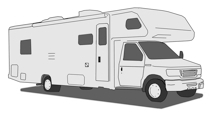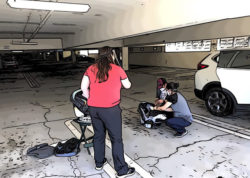As most people know, impaired drivers (drunk or high) are a menace on our roadways. What is less recognized, however, is that most (57%) of the children who die in impaired-driver crashes are passengers of the impaired driver. Unsurprisingly, studies show that children riding with an impaired driver are less likely to be properly restrained, and restraint use decreases with increasing child age and driver blood alcohol content. And, since the driver survives 71% of these crashes, many children who perish would likely survive if properly restrained.
Read More from “Editorial: Impaired Driving Is a CPS Issue”Topic: SRN Editorials
Editorial: RV Travel Savings Unlikely to Pencil Out When Safety Is Added to the Equation
CPSTs should be prepared for a potential rise in RV interest among families. In a study published earlier this year, researchers compared the cost of visiting nine popular U.S. tourist destinations over three vacation durations. For every scenario, the researchers concluded that traveling by RV was significantly less expensive than trips involving other modes of transportation (planes, cars) or lodging (hotels, rental properties).
Read More from “Editorial: RV Travel Savings Unlikely to Pencil Out When Safety Is Added to the Equation”A CPS Team’s NDCF Journey Continues
Part 4 of a 4-part series. This article appeared as an editorial by Denise Donaldson and is followed by links to part 1, 2, and 3 of this series, information about the steps she took to prepare her checkup-event team and use the NDCF at checkup events.
Articles in a few of the past SRN issues have covered editor Denise Donaldson’s Seattle-area team as it transitioned to using the National Digital Car Seat Check Form (NDCF). This report provides an update on hardware and basic troubleshooting.
Read More from “A CPS Team’s NDCF Journey Continues”Insights From a Team Adopting the NDCF, Part 3: Things Get Real
Part 3 of a 4-part series. At the end of this article, you'll find links to parts 1, 2 and 4 of this series, which include an editorial by Denise Donaldson about why her team is adopting the NDCF and information about the steps she took to prepare her checkup-event team.
After preparing over the winter to use the NDCF, my Car Safe Kids staffers eagerly jumped in with both feet during our first checkup events of 2022, held at Seattle-area hospitals on March 5, March 26, and April 9.
Read More from “Insights From a Team Adopting the NDCF, Part 3: Things Get Real”Insights From a Team Adopting the NDCF, Part 2
Part 2 of a 4-part series. This article is followed by links to part 1, 3, and 4 of this series, an editorial by Denise Donaldson about why her team is adopting the NDCF and information about the steps she took to use the NDCF at checkup events.
Here are the first steps taken by the Car Safe Kids team in the Seattle area to begin using the NDCF.
An annual winter hiatus provided an ideal opportunity for my CPS team, Car Safe Kids, to do some preparation and training before adopting the NDCF in 2022. For readers who are also considering this process, here are the steps I’ve taken so far:
Read More from “Insights From a Team Adopting the NDCF, Part 2”Transition to NDCF to Energize CPS Data
Part 1 of a 4-part series. This article appeared as an editorial by Denise Donaldson and is followed by links to part 2, 3, and 4 of this series, information about the steps she took to prepare her checkup-event team and use the NDCF at checkup events.
Since the mid-90s, I’ve run a CPS program based in the Seattle area. My team and I have logged thousands of seat checks, and after each checkup event, I let the team and our host agency know our totals—how many checks overall, how many for expectant parents, rear- versus forward-facing, and so on. Then, at year-end, I calculate annual and cumulative figures of our efforts.
Read More from “Transition to NDCF to Energize CPS Data”New Job Postings Webpage for CPSTs!
SRN is happy to announce that it has added a new webpage to help CPST job seekers and employers connect with one another. From our website, find this resource under Resources/Job Postings for CPSTs.
Tips for Returning to In-Person Education
Virtual education has filled in many educational gaps during this year of pandemic, but some CPS programs are cautiously conducting in-person education, as well. Those that do must employ many new approaches in order to mitigate risk while ensuring quality of service.
It’s Time to Think About Autonomous Vehicles
I’d have to have my head planted firmly in the sand if my initial skepticism about self-driving vehicles hasn’t budged over time. In a few short years, what has gone from bold predictions by certain tech giants has developed into mainstream acceptance. Target dates for various rollouts of autonomous vehicles seem right around the corner, rather than in some sci-fi future. In September, the DOT released safety guidelines for autonomous vehicle performance, including a model for state policies.
Read More from “It’s Time to Think About Autonomous Vehicles”
Debate in the NICU Continues: What’s a CPST to Think When Doctors Disagree?
As readers know, I am not a doctor. Occasionally, though, as CPSTs we must consider certain medical conditions that influence the safety or children as vehicle passengers. Fortunately, there’s no need for CPSTs to hold a medical degree; simply follow the advice of doctors regarding the relevant symptoms of a diagnosis and how they might influence a child’s safety (either in a crash or during normal riding). To guide us, we are fortunate to have peer-reviewed scientific studies and policy statements from the medical community.
Read More from “Debate in the NICU Continues: What’s a CPST to Think When Doctors Disagree?”


